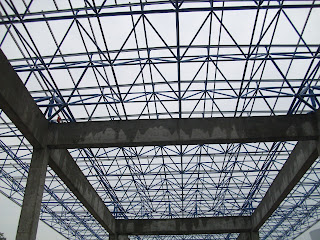Wind Load & Steel Space Frames: Designing for High-Wind Regions
When large-scale buildings utilize steel space frames, wind loads must be a critical design consideration for projects located in coastal areas, typhoon zones, high plateaus, or regions prone to severe storms. This article outlines key design principles, common misconceptions, and engineering recommendations for steel space frames in high-wind environments, helping you ensure structural safety and practical usability.
1. Why Wind Load Matters for Space Frames
Increased wind speed directly amplifies both the pressure and suction forces exerted on structures, particularly in large-span, lightweight, and extended-span configurations.
Wind loads on space frame structures involve not only static pressures but also vortex-induced forces, flutter effects, dynamic loads, and fatigue impacts.
Neglecting the combined effects of wind loads with other loads (snow, seismic, live loads, high-altitude wind speed variations) during design significantly increases structural safety risks.
2. Key Design Considerations for Steel Space Frames in High-Wind Regions
A. Accurate Wind Speed & Exposure Classification
Verify compliance with local wind speed standards (e.g., basic wind speed, near-ground wind, terrain correction factors).
Account for wind amplification effects from building height, surrounding obstructions, and topography. Designers must specify “storm-period design” rather than average conditions.
B. Structural Form & Aerodynamics
Optimize roof geometry, edge details, opening locations, and spatial grid shapes to minimize wind pressure concentration and negative pressure suction.
Avoid excessively shallow roofs or unobstructed large-span planes, as these forms are more prone to vortex shedding or wind-induced vibration.
C. Connection & Node Strength
Wind loads may cause shear forces, tensile forces, and bending moments to accumulate at nodes and member ends. Therefore, the overall stiffness and strength of nodes must meet requirements for high-wind regions.
Prefabricated nodes must ensure manufacturing and installation accuracy to minimize localized stress concentrations caused by tolerances.
D. Dynamic Effects & Fatigue
For spatial truss structures with significant height and span, consider wind-induced vibration, flutter, and fatigue accumulation—not just static verification.
Design should incorporate fatigue-resistant nodes, appropriate damping, or structural added mass (e.g., wind dampers, vibration isolators) as warranted.
E. Load Combinations & Code Compliance
Wind loads often require combined verification with live loads, snow loads, and seismic loads. Spatial frame designs must meet local code requirements for combined wind-snow and wind-live load combinations.
Use coefficients, directional factors, and combination factors recommended in codes to avoid reduced safety margins due to oversimplified design.
3. Common Problems & Mistakes to Avoid
Incorrect use of wind speeds or neglecting storm effects leads to underestimation of wind loads.
Insufficient stiffness at joints and connections, coupled with failure to account for fatigue and dynamic effects, may cause cracks or bolt loosening over time.
Neglecting edge details, eaves, and opening areas results in excessive negative pressure zones, creating suction forces that act against the space frame.
Failure to account for wind load impacts on prefabricated installation, such as temporary loads during construction or storm-period safety protocols.
4. Practical Steps to Ensure Reliable Wind-Resilient Space Frame Design
Early involvement of wind engineering consultants to provide wind tunnel or numerical simulation support.
Define project extreme wind speed data (e.g., 50-year, 100-year return period) and apply it for structural verification.
Prioritize high-strength steel and precise node designs to ensure member-to-node compatibility.
Control construction wind loads, storage layouts, temporary bracing, and installation sequences during erection.
Establish a long-term monitoring and maintenance system: Track structural deformation, vibration, and connection loosening to enable timely responses to human-induced or extreme wind damage.
If your project is located in high-wind areas, typhoon-prone regions, or open landscapes, steel space frame design demands meticulous attention. Contact us for specialized wind load verification and wind-resistant optimization services for space frames. Build safe, stable, and future-proof structures.




评论
发表评论